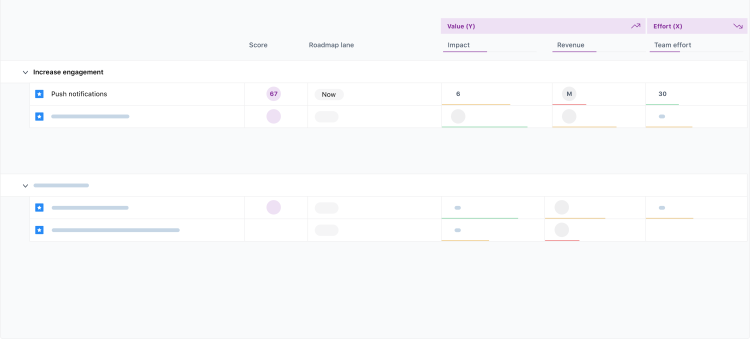
Software roadmap template
Discover it live
Preview

What is a software roadmap?
A software roadmap visualizes the high-level overview, and main steps in the process, of developing software products. Product teams or engineering departments commonly leverage a software roadmap for better visualization of the high-level planning, along with the product design and development.
The purpose of a software roadmap is for long-term product strategy and this document is often shared with other functional departments like marketing and sales.
And with the help of our software roadmap template, you will make headway at double the speed!
What are the benefits of using a software roadmap?
As with other roadmaps, a software roadmap can bring crystal-clear alignment on what’s happening, when, and why across everyone involved in the development of a product.
It also helps to visualize how the resources of specific employees or departments are allocated over time, plus the economic impact and customer value for all features that make it into the roadmap.
But the software roadmap benefits one audience more than others, and that’s developers. For development teams, a software roadmap can be hugely motivating — it gives them visibility over how their daily tasks impact the development of the product and, therefore, benefit the end user. This can provide a significant boost of engagement and a sense of contribution and purpose.
As Mark Weinberger of EY once said: “People want to do well and do good. They want to understand how they’re making a difference in the world.”
How do you use a software development template?
Step 1: Before you can start planning the actual initiatives/opportunities/features of your product, you need to decide on the “why?”. Define who your target audience is, what their reasons are for using your product, and what they expect to achieve with it.
Step 2: Spend time with all audiences of your software roadmap. While viewing the map with your development team, you will focus on allocating resources and workloads. When talking to other stakeholders, the real question is how you’ll profit from a particular feature, the expectation in terms of increased revenue and improved company reputation. Different audiences will have different feedback on your roadmap, that’s why it is essential to use a software roadmap template that’s easy to adjust for everybody’s needs.
Step 3: Prioritize the strategic opportunities of your product. Start with the highest level and then continue adding more details. When considering the cost of a build, it’s the development costs you should look at most closely.
Step 4: Update your roadmap regularly — this is not a document that you create once and never touch again! Add fresh information and adjust your software roadmap template according to new data, but make sure you’re still moving towards your overall strategic goal.
Now that you know how to use a software roadmap, it’s time to put that knowledge to work. Roll up your sleeves and start applying your knowledge with our software roadmap and prioritization template today!
Get started with the software roadmap template now

Pre-installed apps
Priority Ratings
Set up a custom prioritization framework
Benefits that come from using this template
Powerful prioritization framework
Build a strategic product roadmap
Seamless integrations
Ready to use & fully customizable
Learn how to use airfocus templates effectively
More templates
Experience the new way of doing product management


Experience the new way of doing product management




